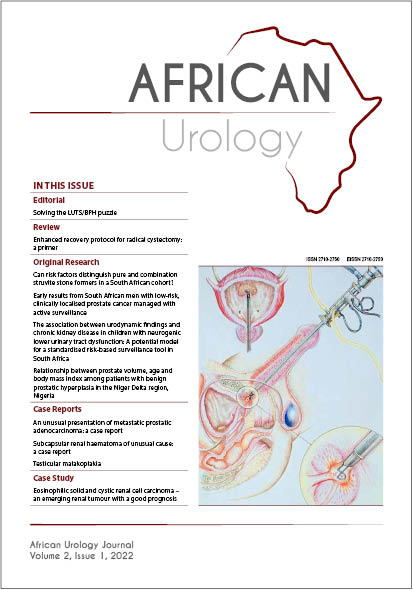Can risk factors distinguish pure and combination struvite stone formers in a South African cohort?
Main Article Content
Abstract
Purpose: This study aims to assess whether clinical variables distinguish pure struvite stone formers from combination/mixed struvite stone formers.
Methods: A retrospective folder review was done on patients in the Western Cape, South Africa between January 2015 and December 2020. All patients with stone analyses reporting struvite were included. Demographic data, stone factors, surgical management, and risk factors for struvite nephrolithiasis were recorded. Risk factors and clinical variables of pure struvite stone (PSS) formers and combination/mixed struvite stone (CSS) formers were compared. This protocol was approved by an institutional review board.
Results: A total of 53 patients were included, 30 (56.6%) with PSS and 23 (43.4%) with CSS. There was a female predominance of 32/53 (66.7%). The mean age (SD) was 46 ± 13 years. There were no differences in age (46 ± 12 vs 45 ± 15, p = 0.371) or gender distribution between the PSS and CSS groups.
There were no differences between PSS and CSS patients in the prevalence of urinary tract infections (UTI), staghorn configuration, location of stones, stone management or the prevalence of any individual risk factor (immunosuppression, anatomical abnormalities, recurrent UTIs) examined.
The distribution of the number of risk factors differed significantly between PSS and CSS formers (p = 0.022, Mann-Whitney U-test).
Conclusion: Although the distribution of the number of risk factors was different between patients with PSS and CSS formers, overlap in the number of risk factors within groups limits the clinical usefulness of this finding. Individual risk factors do not discriminate PSS formers from CSS formers and should not be used to guide clinical decisions. Routine stone analysis is recommended in struvite nephrolithiasis.
